- Submissions

Full Text
Academic Journal of Engineering Studies
Science Popularization Methodology
Dan Ophir1* and Galit Ophir2
1Ariel University, Ariel, Israel
2Reichman University Herzlia, Israel
*Corresponding author: Dan Ophir, Department of Computer Science, Israel
Submission: May 17, 2022; Published: June 01, 2022
.jpg)
ISSN:2694-4421 Volume3 Issue1
Abstract
These days mankind has been making great efforts to eradicate the corona virus. The trend is positive in this effort to cope in a situation where scientists develop vaccines and other means to combat the virus, but the virus, on the other hand, develops variant mutations. Currently, the COVID-19 plague has been considerably reduced in most countries through vaccines and other means. Some of the means developed in this challenge are technological, on the one hand, and changing the behavioral habits of society, on the other hand. We will present here a model that illustrates this paradigm. The technological means in the issue raised here is the Zoom application, which is a social network application that allows simultaneous contact through a network for users to communicate and impart knowledge, in order to take advantage of the “closure” period-social isolation (which is one of the means used in dealing with epidemics). Enrichment of knowledge is usually a distant goal. It can be concluded that we now have a "Facebook State", which has billions of members, with their own language, and similar behavioral patterns. Social networks play a number of roles:
Social networks play a number of roles:
- The Zoom application supports the physical transmission of information, in a short time, at long distances simultaneously to the masses.
- The social network has helped people gather relevant material from the networks themselves, to construct presentations containing popular science.
- Social networks know how to construct for audiences’ cross-sections of popular science fields according to different social profiles.
Keywords: Zoom; Social network; Advertising; Profile; Target audience; Audience satisfaction; Marketing
Introduction
The corona virus that has invaded the world for the past year and a half has created the need for many adjustments to the new and complex reality that has been imposed on all of us: A reality that includes closures, social disconnections, economic crises, business challenges, and an almost complete dependence on remote connections. The prolonged stay at home due to the closures and the crisis in the employment market has led many people to spend many hours in front of a computer screen. In doing so, the corona crisis, which has negatively affected the entire world, has been challenged by the social networks, which have been an integral part of our lives in recent years, they have long been used not only for creating and maintaining social connections mainly for entertainment. Currently the most popular global social networks are [1,2] Instagram, Pinterest, Vine, Tumblr, and Twitter. In the past, Myspace was also popular. Some online social networks are especially popular in a particular region or country, such as Qzone in China, VK and Odnoklassniki.ru in Russia, tagged in Spain, Orkut in Brazil and India, and in the past, the “guys” and “linked” sites in Israel (Figure 1). Along with the development of social networks, the outbreak of the corona plague around the world has also led to a very significant increase in the volume of the use of the Zoom application software (Figure 2).
Figure 1: The World Map of social networks. For a website showing the current number of members in Facebook (see Facebook).
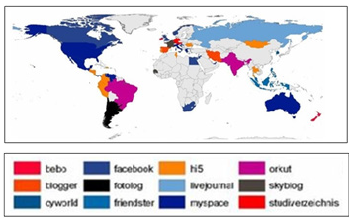
Figure 2: Gallery of zoom participants..
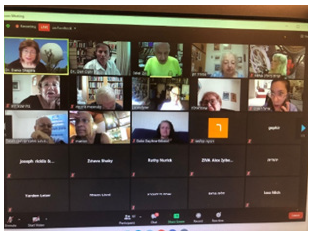
Following the closure of campuses, universities, the cessation of cultural and artistic events, as well as in museums, clubs, and libraries, there has been a huge increase in the daily use of Zoom among many users, including private organizations, in order to keep in touch with different audiences and make lectures, presentations, tutorials, and virtual tours more accessible to anyone with the appropriate computer set-up and internet access. In other words, the new reality that has been imposed on all of us and the need to find solutions to the many challenges and difficulties created by the Corona crisis has caused us all, whether knowingly or not, to use social networks and zoom as the primary tools to deal with these difficulties. One can complain about the age of screens and social networks, but one should recall what happened during the 1918 influenza pandemic (the Spanish flu) in which 50 million people died worldwide. It involved seclusion for extended periods, with or without family and without social networks, computers, and a supportive environment (even at a distance). This differed from today’s Covid-19 pandemic, regarding the positive aspects of today’s technological advances in coping with the crisis. On a personal level, I must admit that the corona pandemic caught me unprepared as well. I am a senior lecturer and researcher in the fields of computer science and mathematics at Ariel University. I hold a PhD from the Weizmann Institute of Science. I have realized that the world has changed and that this change is here to stay. Thus, I have concluded that I will have to change accordingly.
The fact that technology is “flowing in my arteries” has played in my favor. I set myself the goal of taking advantage of the new reality. This includes understanding the technological developments that enable it and the subsequent changes in society’s behavioral habits in order to utilize the vast knowledge and experience I have accumulated over the years. Thus, I intend to utilize the new technology to make science accessible to the general public through diverse and inspiring lectures on various scientific topics and their interface with art, culture, and what lies between them. My initiative is called “The Popularization of Science”. Social networks and applications such as zoom have served as a critical support platform for establishing it and have played a crucial role in its success. They are the subject of this article and serve as a schematic model for others to present their topic in a series of lectures
Modules of the Popularization Pattern
Brand
Logo: The logo of the template will run in various media; it should be relevant to the popularization of science, and attract attention, i.e., catch the eye of a potential user. The logo should have several characteristics to attract attention and be easy to remember and be relevant to the topic it represents. The logo we chose meets the requirements (Figure 3). The logo depicts a huge brain and a small person next to it, which gives the impression of some kind of intimidation; man fears the brain. There is a symbolism here; the mind represents reason, knowledge, and science; man, on the one hand, is afraid and on the other, is curious. A series of popularization lectures is introduced here, with the aim of bringing both of them together. The anomaly of the logo is expressed in the disproportion in size between the size of the brain and the size of the person; the logo is easy to remember because it represents only two objects: the brain and the person.
Figure 3: The chosen Logo: “Brain vs. Fear” [19].
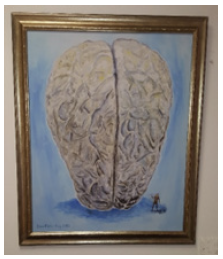
- Website: The website is used to automatically prepare a list of participants with their preferences, which allows the lecturer to upgrade his contacts with potential participants [3]. There are two types of interactivities:
- Real-time interactivity: During the lecture, the lecturer asks the viewers questions and receives immediate answers, for example, in a lecture on illusions the lecturer gives a test to a reality tester (Figure 4).
Figure 4: The lecturer interacts with the audience. The viewer must remember four accessories for further analysis. The participant and the lecturer’s pictures are located in the upper-right corner of the figure.

- Long-term interactivity Viewers initiate their contact with the lecturer by asking questions or making comments at the end of the lecture or at a time convenient via email or through a website. This allows the lecturer to interact with the viewers, who send him relevant lecture materials.
Figure 5: Facebook member registration [3].

- The lecture outlines
Title: The title of a popularized lecture should be intriguing and should capture the viewer’s attention. For that purpose, the title should be exceptional; for example, the title may imply ambiguity, as in the title "The Illusion of Art or the Art of Illusion" [4]. The title can allude to elements whose connection is as distant as in the title: "Architecture, Art, and Mathematics". At first glance, these are distant concepts, and the viewer may be interested in the connection between the three factors. The title. "Logic, how does it deal with paradoxes?" [5] is another type of headline that can entice a potential viewer. Another way to capture potential viewer attention is touching on useful aspects of the lecture: "Game Theory and Their Contribution in Everyday Decision-Making Process" [6]. A title that contains a question mark is often a good title because it indicates the lecturer's appreciation of the viewer. Here the lecturer thinks that the viewer will know how to deal with the question at the end of the lecture. A title that hints, e.g., gives tips on easy financial gains, appeals to the audience, as in the headline: “Understanding Bitchain, and its impact on optimal digital currency investments." Mystery and secrecy disguised within the headline can contribute to interest in the lecture, as in the headline: "What are covert encryptions and what damage can they cause? " Here we encounter another factor that attracts attention in the title, and that is the element of intimidation: if you do not go to the lecture, you will not know how to deal with external threats. Finally, we will present counter examples of a boring title that does not pretend to attract attention, for example, in titles such as "Game theory", "Encryption and Identification" [7], "Bitcoin", and "Computer Games".
- Lecture’s abstract: The abstract accompanies the invitation to the lecture. The role of the abstract is to briefly tell the target audience about the content of the lecture. On the one hand, the abstract should attract potential viewers, and on the other hand, it is advisable to leave the factor of surprise to the lecture itself, for example, by presenting a connection between two different areas. As an example, we have shown an association between encryption and genetics [8]. The summary also tells how the current lecture fits into the series of lectures as part of the popularization of science. Thus, it is possible to advertise the entire series. If the lecture is given as a part of an external organization, it is advisable to thank the organizers for hosting the lecture as a part of their forum.
- A description of the factors that led the lecturer to develop a series of lectures, and an overview of which lectures have already been given as part of the series.
- A reference to the audience’s responses to lectures given so far.
- Conclusions to the above responses. After the opening remarks, it is recommended that the opening slide, which explains the motivation for the lecture, appears. The slide will contain a direct description of events that were effectively dealt with thanks to the means described in the lecture. For example, the first slide provided World War II videos on the music of Richard Wagner (Cabalgata de las Valkyries) [9] and explained the crucial function of the enigma cipher in this event. It began with fireworks against the backdrop of Rossini's impressive music of William Tel's opening "Gallop" [10]. Concluding remarks to the viewers, thanking them for listening, directing them to a slide containing the contact details of the lecturer, in case there are any questions and comments, along with follow-up lectures in the series; referring viewers to a penultimate slide containing the lecture's punch line, expressed with familiar musical accompaniment, conveying the message of the lecture in a pleasant and relaxed atmosphere, for example, Frank Sinatra's famous song "I do it my way" at the end of the lecture entitled: "Poland-Israel stories in the context of culture, science, and what connects them”.
Table of contents/
The table of contents is built hierarchically, as a tree with several levels of detail. Each node in the tree is actually a link to relevant material in the lecture. If we look, for example, at a genealogical tree of the lecture topics: “Time, Space, and Art” [11], we see a branching tree with five levels of detail. An arbitrary route in the tree was chosen: [World > Space > Cosmos > Space-I].
- Presentation/lecture core/contents
The following presentation will serve to popularize science, preferably through visualization and sound effects. There is extensive use of videos, animation, graphical interfaces, supported by programming languages integrated into the middle of the presentation. Several examples are included that are contained in the presentations of my lectures given so far in the series.
Videos: In a lecture entitled: "The Art of Illusions or the Illusions of Art", Charlie Chaplin's video "The Gold Rush" was presented, in which the protagonists suffer from exhaustion, accompanied by hallucinations, a kind of illusion. A soundtrack of Chopin's "Nocturne" accompanies the video. The video is supposed to evoke in the veteran viewer’s feelings of nostalgia, an indulgence in the past - a period in which the film was shown in cinemas (Figures 6 & 7) [12]. Sometimes the videos are critical to understanding a dynamic phenomenon, as in the case of a description of a folding bridge in a lecture: "Architecture, Art, and Mathematics". It is impossible to accurately describe the details of the bridge’s folding
Figure 6: Tree of Contents (a) The whole tree in a miniature size; (b) A partial tree contents.

Figure 7:Charlie Chaplin in “The Gold Rush” demonstrates hallucinations as a type of illusion in the lecture: “The Art of Illusions or the Illusions of Art”.
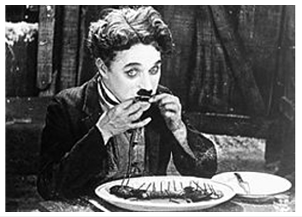
- Audio means: Audio was brought up in a lecture on encryption in the context of the mutual identification of two listeners, talking to two telephone line hunters, and attempting to identify each other.
- Animations: Animations were used in the lecture: "Space, Time, and Art" (Figure 8), in a humorous description of the time traveler paradox, [13] the theory of special relativity.
Figure 8:Twins space encounter, according to the twins paradox of the relativistic theory.

- Simulations:Simulations were presented in the lecture: “Game Theory and Their Contribution in the Decision-Making Process”. The simulation shows the decision tree and the control panel from one node to another node in another branch, depending on the decision made. Another example of simulation is simulating the Roulette game in the casino in the lecture “The Art of Illusion or the Illusion of the Art”.
Figure 9:The submarine computerized game, embedded in the slide presentation. The left and the right big squares represent the battle fields seen from the both opponents’ points of view, respectively.

Management of Components
Sources
Social networks, such as Facebook, WhatsApp, and Wikipedia, provide knowledge that is later upgraded, by combining it with knowledge from other sources such as personal knowledge and computer software, mostly written by the author of the article [14].
Multilingualism
Multilingualism is treated in the lecture with the help of control buttons (Figure 10), allowing the lecturer to select slides in the desired language. The system currently supports three languages: English, Polish, and Hebrew, see for example, the title slides of a lecture in those three languages, which are shown (Figure 11).
Figure 10:Using three push buttons: “Eng.”, “Pln.”, and “Heb.”, choosing the required language english, polish and Hebrew, respectively, which describe the slide.
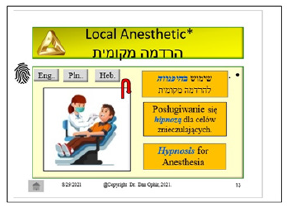
Figure 11:An example of title slides of a lecture in the three languages - from left to right: Polish, Hebrew, and English.

Invitation to the lecture-distribution
Social Networks, family, and personal friends on Facebook Ophir D [1] WhatsApp, and LinkedIn.
Institutional content bodies, this includes, for example, pensioners, the association of engineers, technion graduates, Weizmann Institute graduates, and second-generation holocaust survivors.
Feedback from the network
The spectators are encouraged to ask questions at the end of the lecture, offering constructive suggestions. The audience remarks are a cumulative information, it should be separated from the rest of the information for the purpose of upgrading the presentation in the following versions. Filtering is done in several channels: textual, audio, and visual. Each channel has specific software packages for processing text, sound and image.
Indices
The measurements are a tool in the hands of lecture organizers to compare different lecturers who deliver the same topic, or between different audiences’ referring to the same topic of the same lecturer, to examine different preferences. Indices make it possible to derive different conclusions considering giving the further lectures, such as emphasize some aspects in the next versions of the lectures.
Payment
The lectures were mostly done for free, voluntarily in groups of hundreds of spectators. In the future, a module can be added to the lecturer’s website, which will be responsible for collecting payment via credit cards and money transfer companies, such as Pay Pal.
Database of the lectures
The lectures are listed in the Excel file (Table 1) with links to the relevant folders and files.
Table 1: Table representing a data base related to the lectures and participants.

Subjects
Exact sciences
Bioinformatics: The field of genetics, the structure of the gene, is made up of four nucleotides - amino acids, in a lecture on encryption.
Mathematics: Concept series, Fibonacci series, concept of the limit, golden ratio, in the lecture: “Architecture, Art and Mathematics”.
Biology: Blood Types - ABO, mentioned by Prof. Leopold Hirschfeld, of Jewish-Polish descent, worked on the discovery of our blood types - in a lecture: “My Story in the background of Polish-Israeli Cultural and Scientific Relations”.
The humanity and social sciences
Communication: The concept of fake news, disinformation (in “Cryptography and Identification”).
Psychology: The concept of a reality test–a reality test, verbal and performance intelligence, CBT (Cognitive Behavioral Therapy), (in “Illusion of Art and Art of Illusion”).
History: The crucial event of May 26-27, 1941, Atlantic Ocean, west of Brest, the Allied victory over the Nazis, turning points in World War II battles (in “Cryptology and Identification”).
Literature: Shaul Tchernichovsky, one of Israel’s national poets, wrote in his poem: “A man is not, but a pattern of the landscape of his homeland.” This quotation was mentioned in the lecture “Childhood in the background of Polish-Israeli cultural and scientific relations”.
Art
Painting: Pictures of Francisco Goya, Van Gogh, Escher, Vasareli, Einhorn, and Dali Salvador (in “Illusion of Art and Art of Illusion”).
Sculpture: The Rapaport sculpture of the Warsaw-Ghetto Uprising (in “Childhood, Poland-Israel Culture, and Science”).
Music: Gallop in the William Tell Overture, by Rossini; Giovacchini Antonio (in “Illusion of Art and Art of Illusion”).
Cinema: “Obscene Proposal” - Robert Radford, “Gold Rush” - Charlie Chaplin (in “Illusion of Art and Art of Illusion”). In Cryptology the history of Enigma was described on the background of “Ride of the Valkyries” [9].
Technology
Image processing: The meaning of the pixel and the RGB primary colors were explained in lectures: encryption, and in a lecture on graphics, respectively (Figure 12).
Figure 12:Three titles of given subjects in lectures in science popularization representing image processing and graphics, and how these slides were created.
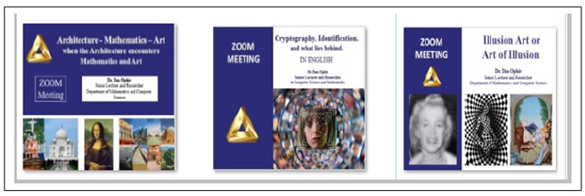
Optical instrumentation: Sextant-an instrument for measuring spatial angles; the Hubble-Space-Telescope, a telescope built for space exploration; the Helmet-Mounted Display (HMD)- another optical tool. The instruments were included in the lecture: “Time, Space and Art”.
Feedback
Questions, thanks, and comments from viewers
Viewers have an opportunity to express themselves, ask questions orally at the end of the lecture, or in writing via emails, telephone conversations, and by other social servers.
Lecture recordings
These recordings allow for retrospective anticipation of the lecture, drawing conclusions - feedback to the repeated versions of the lecture on the subject.
Registrants’ participants
One of the results of giving a lecture is the list of participants with their contact details; this makes it possible to contact them in the future by offering them to listen to new lectures.
Payment for the lectures
Most of the lectures are free, in case the lecturer is paid, and the payment is paid in advance, a mechanism for returning the money must be maintained. The payment can also be flexible, that is, the price will be determined by the number of participants, and if the actual number of participants exceeds the estimated amount, part of the payment will be refunded to the viewer.
Techniques
Presentation
The Tools are modular, allowing one to transfer slides from lecture to lecture without a complicated adjustment. There is use of advanced technological means such as animations and integration of integrated computer programs.
Figure 13:Demonstration of a video, in which the lecturer plays the role of a magician with a trick of “invisibly” substituting the king card for the Queen card.
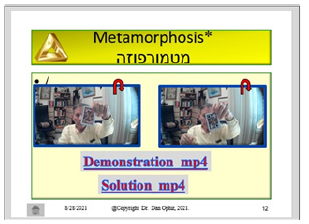
Cover: The idea is to convey serious material in a humorous, entertaining manner. There are cases where the lecturer also takes on the role of an actor, as shown for example in a video, explained by the lecturer, as in one of the videos where the actor (namely, the lecturer) performs the role of a magician (in “The Art of Illusion or the Illusion of Art”) (Figure 13).
Marketing and distribution
Localization: The site automatically allows one to receive Google’s list of values, which enables the lecturer to be in contact with the potential institution (Figure 14).
Figure 14:Flow diagram demonstrating schematically the information flow among the relevant entities constituting the lecture: collecting raw data, announcements, invitations, registration, lecturing, feedback.
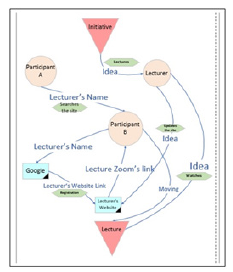
Interactivity: There are two types:
a. Directly by contacting the institutions and people
representing them, by presenting the lecturer’s profile, and a list of
possible lectures to be chosen from for the lecturer’s list.
b. Indirectly posting in well-known social networks:
Facebook [1,15], WhatsApp, and LinkedIn [2] and the lecturer’s
website [3]. This includes showing videos from given recorded
lectures, messages thanking people, describing satisfaction from
the lecture itself given in a way that arouses curiosity.
Conclusion
We have described the stages in the development of the Entrepreneurship: “Science Popularization” for the public. We have described examples of several science fields that have already been incorporated into the newly generated product form. The considered domains are the exact sciences, the humanities and social sciences, and the arts. This knowledge, partitioned into subfields, resembles the university departments’ classification or the Dewey’s decimal library classification. The article defines a model that can be imitated and extended to other fields - not necessarily an academic one, for example, military and foreign languages learning. The corona virus served as a catalyst for creating a digital communication framework for knowledge gathering, on the one hand, and on the other hand, large population groups were created. Users of the above framework were attracted for the following reasons [14,16]. Departure for forced leave; freeing up many leisure hours in some sectors that continued to work from home and saved many hours traveling in traffic jams to and from their work; closing entertainment venues (theatres, cinemas, and more). All of this has created a desire within the population desiring entertainment, creating new consumption patterns that will probably remain the same - due to the corona virus and to the effect of momentum [15]. I tried to take advantage of the emerging patterns, and tried to determine where the audience could, in a pleasant and safe way, increase its knowledge and intellectual levels, and discover new possibilities in the new emerging reality of a worldwide pandemic. The popularization venture model is the “tip of the iceberg” in discovering new possibilities in using Zoom (or similar digital applications) [17]. We have seen that in addition to common usages such as in scientific conferences, academic teaching, and teaching children, new areas have entered the digital meetings industry,which until now have maintained a distance from the public. Some new notable areas in virtual encounters are as follows:
Trials by courts
They have begun conducting U.S. trials through Zoom, with the entities taking part in the trial: the judge, defendant, defence attorney and others sitting at home [18].
Medicine
Consultations may take place using remote control. For example, today ultrasound tests may be performed with the help of telemedicine, at the patient’s home, by the attending physician using the telephone’s remote control.
References
- Ophir D (2003) Facebook.
- Ophir D (2003) LinkedIN.
- Ophir D (2021) Website.
- Sekel Al (2006) The ultimate book of optical illusions. Library binding.
- Baronett S (2018) Logic: An emphasis on formal logic, Paperback.
- Neumann JV, Morgenstern O (2020) Theory of Games and Economic Behavior. 60 Anniversary commemorative edition. Princeton University Press, US, pp. 1-776.
- Bumett S, Paine S (2001) RSA security’s official guide to cryptography. McGraw-Hill Education, USA, pp. 1-432.
- Piercer BA (2016) Genetics a conceptual approach. (7th edn), WH Freeman publishers, USA, pp. 1-823.
- Wagner R (1851) Ride of the Valkyries. La Cabalgata de las Walkyries. Boosey & Hawkes, UK.
- Rossini (1829) Gallop-William Tel Overture.
- Dainton BF (2010) Time and space. (2nd edn), pp. 1-448.
- Chaplin C (1925) The Gold rush.
- Campbell JW (1935) Clock problem of relativity. Phi Mag 19: 715-720.
- Meert B (2019) The complete guide to facebook advertising. In: Felicitas A (Ed.), 2017th (edn), USA, pp. 1-336.
- Facebook (2000) The current members’ number.
- Ophir D (2020) The crown for the coronavirus. AES 1(3): 1-2.
- Ophir D (2003) Brain’s fear. Rishon Le-Zion, Private Collection, Painting, Israel.
© 2022 Dan Ophir. This is an open access article distributed under the terms of the Creative Commons Attribution License , which permits unrestricted use, distribution, and build upon your work non-commercially.
 a Creative Commons Attribution 4.0 International License. Based on a work at www.crimsonpublishers.com.
Best viewed in
a Creative Commons Attribution 4.0 International License. Based on a work at www.crimsonpublishers.com.
Best viewed in 







.jpg)






























 Editorial Board Registrations
Editorial Board Registrations Submit your Article
Submit your Article Refer a Friend
Refer a Friend Advertise With Us
Advertise With Us
.jpg)






.jpg)














.bmp)
.jpg)
.png)
.jpg)










.jpg)






.png)

.png)



.png)






